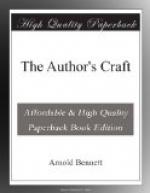IV
The more closely one examines the subject, the more clear and certain becomes the fact that there is only one fundamental artistic difference between the novel and the play, and that difference (to which I shall come later) is not the difference which would be generally named as distinguishing the play from the novel. The apparent differences are superficial, and are due chiefly to considerations of convenience.
Whether in a play or in a novel the creative artist has to tell a story—using the word story in a very wide sense. Just as a novel is divided into chapters, and for a similar reason, a play is divided into acts. But neither chapters nor acts are necessary. Some of Balzac’s chief novels have no chapter-divisions, and it has been proved that a theatre audience can and will listen for two hours to “talk,” and even recitative singing, on the stage, without a pause. Indeed, audiences, under the compulsion of an artist strong and imperious enough, could, I am sure, be trained to marvellous feats of prolonged receptivity. However, chapters and acts are usual, and they involve the same constructional processes on the part of the artist. The entire play or novel must tell a complete story—that is, arouse a curiosity and reasonably satisfy it, raise a main question and then settle it. And each act or other chief division must tell a definite portion of the story, satisfy part of the curiosity, settle part of the question. And each scene or other minor division must do the same according to its scale. Everything basic that applies to the technique of the novel applies equally to the technique of the play.
In particular, I would urge that a play, any more than a novel, need not be dramatic, employing the term as it is usually employed. In so far as it suspends the listener’s interest, every tale, however told, may be said to be dramatic. In this sense The Golden Bowl is dramatic; so are Dominique and Persuasion. A play need not be more dramatic than that. Very emphatically a play need not be dramatic in the stage sense. It need never induce interest to the degree of excitement. It need have nothing that resembles what would be recognisable in the theatre as a situation. It




